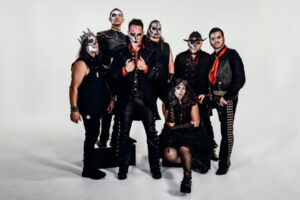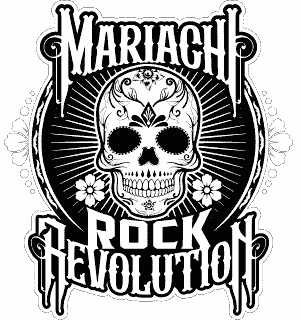
You know that moment when the mariachi band walks into the restaurant and everything changes? The whole vibe shifts. People stop talking, phones go into video mode, and suddenly everyone’s connected to something bigger than themselves. That’s the power of mariachi—it’s not just music, it’s pure cultural electricity.
But here’s what’s wild: mariachi is basically the world’s first fusion genre. Way before rock met hip-hop or country went pop, mariachi was already mixing it up, creating something completely new from totally different worlds. And that’s exactly what we’re doing with Mariachi Rock Revolution—we’re just the latest chapter in mariachi’s long history of evolution.
Three Cultures Walk Into a Bar …
Picture this: It’s the 1500s in Mexico. You’ve got Indigenous people who’ve been making incredible music for centuries—drums that could shake the earth, flutes that sounded like spirits. Then Spanish colonizers show up with their violins, guitars, and harps, thinking they’re going to teach everyone “proper” music.
But here’s the thing about musicians—they don’t care about politics or power plays. They hear something cool and they want to play it. So Indigenous musicians didn’t just copy Spanish instruments, they made them their own. They re-tuned guitars, gave violins new voices, and made harps sound like nothing Europe had ever heard.
And there was a third ingredient most people forget: enslaved Africans brought rhythms that were absolutely essential to what became mariachi. That irresistible groove, that syncopation that makes you want to move—that came from Africa. Without it, mariachi would be just another folk style instead of the heart-pumping, soul-stirring music we know today.
When these three musical worlds collided, they created something called “son”—a type of Mexican folk song and the core song structure that mariachi is built on. It wasn’t one culture taking over another. It was three cultures jamming together and creating something none of them could have made alone. Sound familiar? That’s the same spirit we bring to every Mariachi Rock Revolution show.
From Farm Workers to Superstars
Early mariachi musicians were basically the ultimate hustlers. They were farm workers who figured out that playing music could get them better pay and more respect. They’d show up to parties in simple white cotton clothes with whatever instruments they could get their hands on—mostly strings, no fancy brass section yet.
Then the Mexican Revolution hit in 1910, and everything changed. The old system collapsed, musicians moved to cities, and suddenly they had to play for all kinds of crowds. Want a waltz? Sure. A polka? Why not? Jazz number? Let’s do it. Mariachi musicians became musical chameleons, adapting to survive.
When radio exploded in the 1920s and 30s, mariachi got even more adventurous. They started incorporating jazz and Cuban influences. And then came the moment that split the mariachi world: someone added trumpets.
Old-school purists lost their minds. “This isn’t real mariachi!” they said. Sound familiar? It’s the same argument every time music evolves. But guess what? Those trumpets became so essential that now you can’t imagine mariachi without them. The lesson? Sometimes the “wrong” thing becomes the right thing. We think about that every time we plug in our electric instruments.
The Music That Travels
Here’s what’s beautiful about mariachi: it travels. It doesn’t stay locked in one place or one culture. In the U.S., it became a powerful symbol for Mexican Americans, especially during the Chicano Movement of the 1960s. But it didn’t stop there. Today you’ll find mariachi bands in Japan, Egypt, Sweden—everywhere.
And mariachi keeps having conversations with other music. Johnny Cash put mariachi-style trumpets in “Ring of Fire.” Linda Ronstadt’s mariachi album became the best-selling non-English album in U.S. history. Hip-hop producers sample mariachi and rock bands like Calexico build whole sounds around it.
This isn’t stealing—it’s what music does. It connects. It crosses borders. It brings people together who might never meet otherwise. That’s what we’re all about—using mariachi’s natural fusion power to build bridges between musical worlds.
Electric Visions in Austin
Want to see mariachi’s future? You’re looking at it. Here in Austin, we’re literally plugging mariachi into amplifiers and blowing minds. What we do with Mariachi Rock Revolution is take all the soul of traditional mariachi and give it the energy of an arena rock show. Think Trans-Siberian Orchestra meets the border—that’s our vibe.
Our electric violin—the 7-string fretted Viper—is the first of its kind in Latin music. When we fire it up, it’s like watching mariachi get struck by lightning. But here’s the thing: we’re not trying to replace traditional mariachi. We’re trying to show what it can become when you push it to its limits.
Austin’s mariachi scene is incredible. The University of Texas has a mariachi program that’s been going since 1977, named after border studies pioneer Dr. Américo Paredes. They’ve got two levels—one for beginners, one for advanced players—and everyone learns to both sing and play instruments. It’s keeping tradition alive while training the next generation.
Then there’s Austin Soundwaves’ “Mariachi Para Todos” program, which our shows help support. It’s free, it’s for all ages (literally 10 to 55+), and it welcomes everyone—whether you grew up with mariachi in your family or you’re hearing it for the first time. They started small in 2015 but now they’re performing all over Texas. These are the programs that keep mariachi’s roots strong while new branches like ours reach for the sky.
Why This Matters to Us
Here’s the thing: mariachi proves that the best music doesn’t come from staying pure. It comes from mixing it up, taking risks, and staying open to new ideas. Every time mariachi absorbed something new—African rhythms, Spanish instruments, jazz influences, rock energy—it got stronger, not weaker.
We’re part of that same tradition. When we take a classic mariachi song and give it crushing guitar riffs and powerful drums, we’re doing exactly what mariachi musicians have always done: taking the music they love and making it speak to their time, their audience, their experience.
The musicians doing mariachi today, whether they’re playing traditional songs in a restaurant or shredding electric violin on stage, are all part of the same story. We’re keeping something alive while pushing it forward. Traditional mariachi groups and rock fusion bands like us—we’re all part of the mariachi family.
When you hear mariachi—whether it’s the classic version or our wild fusion—you’re hearing proof that music is stronger than borders, that cultures can come together and create something amazing, and that the best traditions aren’t museum pieces. They’re living, breathing, evolving entities that grow stronger with each generation.
That’s why mariachi hits so hard. It’s not just music—it’s the sound of cultures connecting, of people finding common ground, of traditions that refuse to be locked in the past. It’s the sound of life itself: always changing, always growing, always bringing people together.
What’s happening in Austin right now is the perfect example of mariachi’s ongoing conversation between tradition and innovation, and we’re bringing it all together on stage at the Long Center on September 14th when Mariachi Rock Revolution will be joined by Grammy winner Rick Treviño and Mariachi Paredes, the performance mariachi ensemble from the University of Texas at Austin. We’re kicking off Hispanic Heritage Month with our “performance with a purpose” benefiting Austin Soundwaves Mariachi Para Todos community music program. Last year’s inaugural event enabled us to buy a new set of instruments for their educational nonprofit, and we’ve got even bigger plans this year.
So the next time you hear those trumpets and that deep bass—whether it’s acoustic or electric—remember: you’re not just listening to a song. You’re hearing centuries of cultures talking to each other, creating something beautiful together. That’s the real power of mariachi—it’s been bringing people together since day one, and it’s not stopping anytime soon. Join us live September 14th at Electrified Experience 2025 to see it for yourself.
